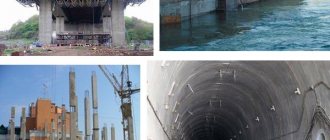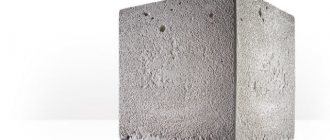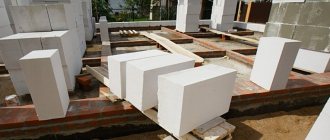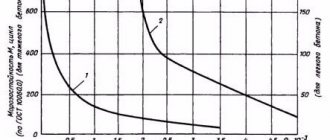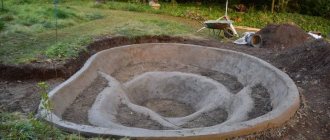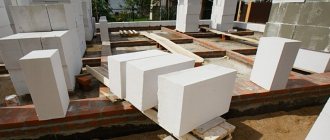Concrete is used everywhere in construction. However, it must be taken into account that its different types differ significantly in quality and strength. To choose the material that is best suited for a particular situation, let’s understand what grades of concrete and its classes are, and how its varieties differ from each other.
The strength of concrete must comply with standards Source i.ytimg.com
Brand and class
Traditionally, in order to distinguish between different types of concrete, its grade was used. Now the class indication is used along with it.
When used under certain conditions, concrete is subject to strength requirements. Each level corresponds to a specific brand. However, deviations in this parameter are not allowed by more than 5%.
During manufacturing, it is impossible to avoid errors even when the procedure for preparing the mixture is carried out exactly in accordance with the recipe. Strength depends not only on the proportions used, but also on the type of aggregate used.
How strong the prepared solution is is measured as follows. A force is applied to one square centimeter of material in a direction perpendicular to the surface. It is measured in kilogram-force. The more concrete can withstand without destruction, the higher its strength.
Strength testing Source sudexperts.ru
Concrete class is strength that is guaranteed. When a certain brand is used, the characteristics of this material can vary significantly. However, when performing construction work, you need to know the tensile strength that will be guaranteed.
The class of concrete is indicated by the letter “B” and a number written next to it. This is an indicator of strength, measured in MPa (it is equal to 10.2 kgf/cm). The brand is designated by the letter “M”, followed by an integer. The correspondence between classes and brands can be seen in the following table.
Table of concrete grades and their characteristics Source ast75.ru
There are the following differences between these characteristics:
- They have different measurement steps. The class is indicated in greater detail compared to the brand.
- In some cases, one column in the table of concrete grades may correspond to two classes of concrete, which more accurately indicate the characteristics of the material.
The strength of concrete is increased with the help of reinforcement Source gazobeton.dp.ua
If these two characteristics were accurate, then the figures would have to differ by 10.2 times. However, as can be seen from the table, such proportionality is not observed.
Table of concrete grades and concrete classes Source trakbeton.ru
Mobility
Mobility indicates the ease of installation of the solution, that is, its ability to spread and fill all the voids into which it is placed. The characteristic is marked with the letter P. Depending on the workability, the following designation of concrete is distinguished:
- P5 – fluid;
- P4 – cast;
- P3 – highly mobile;
- P2 – movable;
- P1 – sedentary.
Based on the indicated mobility grade, builders can select methods of transporting and pouring the solution. Thus, for simple monolithic works, materials marked P3 are suitable, and for complex building structures it is better to select mixtures of P4 and P5. Solutions with high mobility are much easier to lay when making formwork, since during the work you can do without a vibrator. You should only buy plastic material from the manufacturer. It is not recommended to dilute the solution with water to increase mobility, since for this purpose they use not liquid, but special plasticizers.
Based on the information presented, let's consider a separate example. If concrete bst v25 p4 f200 w8 is used for construction, the decoding means that the material is grade M350, can withstand 200 freeze/thaw cycles, has an average level of water resistance and low mobility.
Thus, competent interpretation of concrete makes it easy to navigate the wide variety of products on the market and select exactly those solutions that are optimally suited for specific work.
Author of the article
Various characteristics of concrete
When choosing the right type of this material, you need to remember that it has different characteristics. The most famous is the brand of concrete. This material is made according to a specific recipe from certain grades of cement.
Although it is quite possible to prepare the required building mixture yourself, it is not always possible to make it strictly in accordance with the technology. The highest quality concrete mixtures are those made in production conditions.
The brand designation consists of the corresponding letter and an integer. There are varieties from M50 to M1000. However, for practical purposes only a part of them is most often used: from M100 to M400.
The concrete used may have different characteristics Source gbi555.ru
A more accurate characteristic of strength is to indicate the class of cement. The designation consists of a letter and the maximum permissible pressure for this type of concrete, expressed in MPa. There are classes from B3.5 to B60. It is believed that the hardened material will withstand the load indicated in the digital part of the designation in no less than 95% of cases. Typically, material with characteristics from B7.5 to B35 is used.
The grade and class of concrete are considered the most important, but additional characteristics are also used.
“F” is used to indicate frost resistance. This indicator indicates how many cycles of freezing and thawing the material can withstand without losing its strength. A material with frost resistance characteristics is used. Located within F25-F1000. This parameter is especially important when constructing bridge piers in wet soils. With weak frost resistance, this structure will soon face the threat of destruction.
Frost resistance of concrete can be a very important characteristic Source udarnik.spb.ru
There are special additives that are used in production. They increase the material's ability to withstand extreme cold and a large number of freezing cycles. However, if used excessively, they significantly reduce the strength characteristics of concrete. For temperate climate zones, frost-resistant material F100-F200 is most often used.
Another important characteristic is water resistance. This examines the destructive effects of water that has penetrated into concrete cracks under pressure and turned into ice. This quality is designated by the letter “W”. The produced concrete can have this characteristic within the limits of W2-W20.
In order to increase resistance, special hydrophobic additives can be used. If there is high water resistance, it becomes possible to save on providing waterproofing for building structures located below the water level.
The water permeability of concrete should be low when constructing underwater structures Source beton-house.com
One of the important characteristics is density; the higher it is, the stronger the cement is. Usually the decrease occurs due to the following reasons:
- Porosity of the material (depends on how high quality the concrete was made).
- Insufficient mixing of the composition leads to deterioration in quality.
- If some part of the water has not reacted with other components, then it gradually evaporates. This leads to the formation of voids.
Each composition has features when laying in hard-to-reach places. For this purpose, tubs with taps made in a special way are sometimes used. Help in such cases can be provided by the use of mechanisms that create vibration.
Strength marking
The main parameter of any solution is compressive strength. When mixed, the material undergoes various tests, after which it is marked with the letters M and B. The first letter determines its ultimate strength in kgf/cm². The second indicates the strength parameters in MPA with a confidence probability of 0.95. For example, if we look at concrete b20 f150 w6, we will find out that its strength class is B20, and its grade is M250, that is, the material has an average strength of 262 kgf/cm². Indicators and labeling ratios for different mixtures can be seen below.
| Brand | Class | Strength, kgf/cm² |
| M100 | B7.5 | 98 |
| M150 | AT 10 | 131 |
| M200 | B15 | 196 |
| M250 | IN 20 | 262 |
| M400 | B25 | 327 |
| M450 | B30 | 393 |
| M500 | B35 | 458 |
Considering what this or that brand means, it is worth noting that the strength indicators of mixtures during production are regulated in accordance with GOST 7473-2010 and 25192-2012. Strength characteristics depend on many factors, including:
- ratio of ingredients;
- quality of cement;
- dosing accuracy;
- method and thoroughness of mixing.
How to improve the quality of curing
As you know, complete hardening of the concrete mixture occurs approximately four weeks after laying. The conditions under which it occurs have a significant impact on the compressive strength of concrete.
Some additives increase the strength of this material Source stroyfora.ru
If this process occurs in hot weather, then it is necessary to periodically moisten the surface. Additionally, you can cover the surface from exposure to direct sunlight. To do this, you can apply a coating with a layer of bitumen or use plastic film.
Sometimes additives are added to the mixture to improve characteristics. As a result, it is possible to reduce work time, reduce the cost of construction, or impart special properties to concrete.
In particular, substances that slow down the hardening process can be used. As a result, the concrete coating becomes more durable.
Waterproof
Water resistance is a characteristic of a concrete mixture based on the bond strength within the material. The importance lies in the fact that water, penetrating into microcracks, destroys it from the inside when it freezes.
Water resistance is indicated by the sign W from 2 to 20 - this is a numerical indicator of resistance to the penetration of moisture into the thickness under pressure. To achieve the required hydraulic resistance characteristics, the same hydrophobic cement or other sealing and hydrophobic additives are used.
It is worth noting that the price will be much higher, but a number of positive qualities will appear:
- the opportunity to save on waterproofing foundations in areas with close groundwater;
- extension of service life due to increased frost resistance, in relation to unprotected structures, such as fences, blind areas, concrete paths.
Features of different brands
Each of the brands used is suitable for a certain range of tasks. Below we will consider those that are used most often.
M50-M100
Concrete grade M50 is considered the weakest and most unreliable. However, it has its own scope of application.
Weak concrete cannot be used for structures under tension Source forums.drom.ru
Areas of use
Due to its properties, M300 concrete has been used in a variety of fields. The material is widely used in private construction and is relevant in the construction of industrial structures and buildings.
Almost all types of foundations, blind areas, garden paths, fences, stairs, monolithic floors and walls are made from mortar.
Concrete M300 is used: in the construction of dachas, cottages, low-rise buildings, garages, warehouses, outbuildings, high-rise buildings, roads, industrial premises. Concrete is used to make paving slabs and curbs, reinforced concrete structures, wall blocks, pillars and piles, partitions and ceilings. The use of concrete when laying walls, pouring heated floors, plastering, etc. is also relevant.


